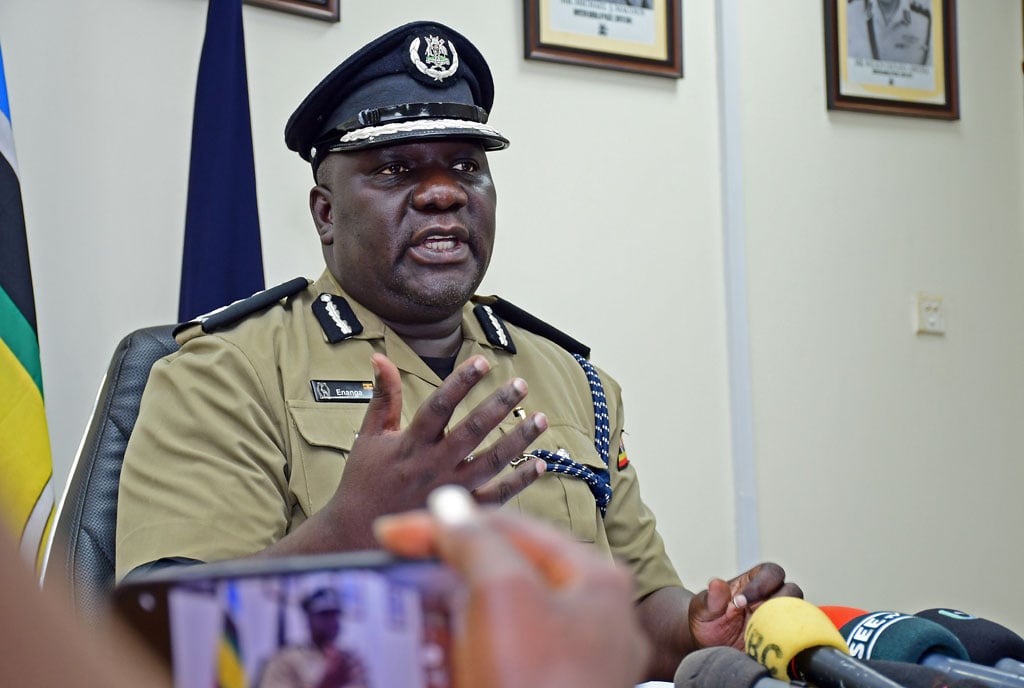Prime
Police mergers spark panic in communities

Police officers are seen during a parade march on Uganda's Indipendence Day on October 9, 2022 at Kololo Independence Grounds. PHOTO/HANDOUT
What you need to know:
- The Force’s stations have in the recent past come under considerable attack from unknown assailants.
The Uganda Police Force has commenced a process of merging a number of its stations and posts that dot the country with the end goal of countering what it considers a “growing threat on its officers.”
The Force’s stations have in the recent past come under considerable attack from unknown assailants.
This has left a trail of destruction that includes deaths and injuries suffered by officers, as well as loss of guns.
Mr Fred Enanga, the police’s spokesperson, told Sunday Monitor that the Force wants to use the mergers as “a tactical arrangement … to strengthen our security posture in detail.”
Mr Enanga further revealed that a study pointed them to which stations and posts are “vulnerable and susceptible to attacks.”
“We have strengthened them, but the area of jurisdiction remains the same,” he said, adding, “We are going to intensify the usage of motor rides and motorcycle patrols to continue covering those areas.”
Mr Enanga said the Force hopes “having larger manpower and strengthening our presence and visibility” at the merged stations will make them less “vulnerable to attacks.”
Mergers underway
Sunday Monitor understands that the Kitigoma and Nakibizzi police posts in Njeru Municipality, Buikwe District, have already been merged. In Luweero, the district security committee approved the merging of Wabitungulu police post with Zirobwe Police Station; Kakinzi and Vumba police posts; Kasiiso police post and Butuntumula Police Station; Kasana Police Station and Luwero Central Police Station, and transferred Kabunyata and Mazzi police posts to Kamira Police Station.
This has left communities in those areas in fear of the unknown. Some residents have been speculating that the mergers could be telltale signs of an anticipated spike in crime.
“The police posts were established to address the high crime rates where they were established and they have been playing a key role,” Expedito Kiroli, the Zirobwe Sub-county chairperson, said, adding, “The removal of these police posts may result in crime and thefts resurfacing.”
Mr Fred Kasirye Zzimula—the Kasanda District chairperson—told Sunday Monitor that while the mergers make economic sense, they will result in the mushrooming of crime.
“Think about districts like Kassanda where we have a lot of hard-to-reach areas—like in the gold mines,” he said, adding, “These small police posts have helped a lot in reducing crime.”
Mr Kasirye urged the government to instead look to push for a subvention to empower the understaffed police posts.
But Mr Enanga was quick to allay fears, saying the police will “continue maintaining visibility … with increased motorised patrol.”
Past attacks
This is not the first-time police’s security apparatus has come under attack. On July 25, unidentified assailants attacked officers manning a roadblock on the Kampala-Gulu Highway.
Two officers were also reportedly stabbed at the roadblock in Kiwumpa Village, five kilometres to Luweero Town Council last Monday afternoon. The assailants then disappeared with two guns after torching a truck.
Luweero appears to be a hotbed of such attacks as on July 24, 2016, an officer was wounded by unidentified machete-wielding thugs, who made off with his gun. Festo Nsubuga, a police officer attached to Ndejje police post in Luweero, was attacked at around 8pm as he returned from duty at Ndejje University.
ALSO READ: Violent crime surges nationwide
On December 17, 2021, unknown assailants gunned down two police officers at Nakasozi police post before fleeing with their two guns. The deceased were identified as Francis Nsubuga and SPC Paul Ddimba.
This was the second attack over a nine-day stretch in which officers were targeted. The first happened on December 7, 2021, at Ssebobbo Village in Sekanyi Town Council, Mityana District.
Enanga weighs in on mergers
“During the 25th Police Council meeting in November 2019, President Museveni directed the Force to review its territorial policing doctrine by focusing more on policing at the sub-county level to help increase efficiency, consistency and stronger partnership with the community at that level.
As a result, police conducted a study of the proposed sub-county policing model to ensure an effective policing policy of the urban and rural areas of the community. The model is premised on the need to enhance police visibility, automation of policing services through advanced technology, consolidation of the available resources and assets at the sub-county.

Police spokesperson Fred Enanga. PHOTO/ABUBAKER LUBOWA
In addition, the key aspects of the model would involve the establishment of at least one police station per sub-county, deployment of not less than 20 personnel, deployment of motorcycle squads, installation of counter phones that are popularised among residents, dedicated counter response teams, critical facilities, modern lockup facilities, better accommodation and medical services.
After a thorough study and evaluation of the model, a framework for the implementation of the sub-county policing model was done. The Force is now piloting the practicability of the model in selected areas within the Kampala Metropolitan policing area and in the central regions of Savanah, Katonga, Ssezibwa and Wamala. Its success will lead to its full-scale implementation plan to cover all 2,624 sub-counties in the country.
There are, however, fears from the local leaders and the communities in the piloted areas that the merger of forces will impair performance in our local policing. We want to assure the public that the restructuring and reorganisation is in its pilot phase. A full spectrum of police services to the entire sub-county will continue to be provided in a more effective and efficient manner...
In the past, we have implemented the merger of forces in a strategic manner but sustained the delivery and responsiveness of policing services. At the sub-county level, the Force is bigger to deliver protection, safety and security.
Therefore, the merger of forces under the sub-county policing model has good potential and will not necessarily lead to a decline in local policing since the sub-county is still at a local level. We will be able to maintain community level outcomes and relationships and sustain the neighbourhood policing strategies.”



